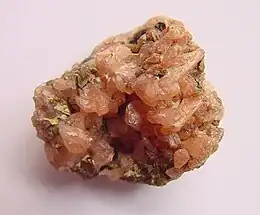| Hureaulite | |
|---|---|
 Hureaulite from the Cigana Claim, Conselheiro Pena, Minas Gerais, Brazil. Specimen size 2.8 cm. | |
| General | |
| Category | Phosphate minerals |
| Formula (repeating unit) | Mn2+5(PO3OH)2(PO4)2·4H2O |
| IMA symbol | Hur[1] |
| Strunz classification | 8.CB.10 (10 ed) 7/C.04-10 (8 ed) |
| Dana classification | 39.2.1.1 |
| Crystal system | Monoclinic |
| Crystal class | Prismatic (2/m) (same H-M symbol) |
| Space group | C2/c |
| Unit cell | a = 17.594(10) Å b = 9.086(5) Å c = 9.404(5) Å β = 96.67(8)°; Z = 4 |
| Identification | |
| Formula mass | 728.65 g/mol |
| Colour | Orange, red, yellow, brown, grey or nearly colourless |
| Crystal habit | Crystals are short prismatic parallel to (100) or equant, sometimes thick tabular, also massive or imperfectly fibrous[2] |
| Cleavage | {100} good |
| Fracture | Uneven |
| Tenacity | Brittle |
| Mohs scale hardness | 3.5 |
| Lustre | Vitreous to greasy |
| Streak | Nearly white |
| Diaphaneity | Transparent to translucent |
| Specific gravity | 3.18–3.2 (measured), 3.23 (calculated) |
| Optical properties | Biaxial (−) |
| Refractive index | nα = 1.640 – 1.654 nβ = 1.649 – 1.659 nγ = 1.655 – 1.662 |
| Birefringence | δ = 0.012 |
| Pleochroism | X colourless, Y yellow to pale rose, Z reddish yellow to reddish brown |
| 2V angle | greater than 60° |
| Dispersion | r<v, very strong[3] |
| Solubility | Easily soluble in acids. |
| References | [3][4][5][6] |
Hureaulite is a manganese phosphate with the formula Mn2+5(PO3OH)2(PO4)2·4H2O. It was discovered in 1825 and named in 1826 for the type locality, Les Hureaux, Saint-Sylvestre, Haute-Vienne, Limousin, France. It is sometimes written as huréaulite, but the IMA does not recommend this for English language text.[7]
A complete series exists from lithiophilite, LiMn2+PO4 to triphylite, LiFe2+PO4, including hureaulite, strengite, FePO4·2H2O, stewartite, Mn2+Fe3+2(OH,PO4)2·8H2O, and sicklerite, (LiMn2+,Fe3+)PO4.[8]
Environment
Hureaulite is a secondary mineral occurring in granite pegmatites.[6] At the type locality it occurs in a zone of altered triphylite, LiMn2+PO4, in pegmatite. Typically occurs very late in the sequence of formation of secondary phosphate minerals.[9] Associated at the type locality with vivianite, Fe2+3(PO4)2·8H2O; rockbridgeite, Fe2+Fe3+4(PO4)3(OH)5; heterosite, (Fe3+,Mn3+)PO4 and cacoxenite, Fe3+24AlO6(PO4)17(OH)12·17H2O. It can be synthesised;[10] most natural hureaulites are Mn-rich compounds but extensive (Mn,Fe) solution is known for synthetic material.[9]
Localities
The type locality is Les Hureaux, Saint-Sylvestre, Haute-Vienne, Limousin, France. Hureaulite is also found in a granite pegmatite known for its phosphates in the Aimorés pegmatite district, at the Cigana claim in Galiléia, Doce valley, Minas Gerais, Brazil, formerly known as the Jocão Mine.[4]
References
- ↑ Warr, L.N. (2021). "IMA–CNMNC approved mineral symbols". Mineralogical Magazine. 85 (3): 291–320. Bibcode:2021MinM...85..291W. doi:10.1180/mgm.2021.43. S2CID 235729616.
- ↑ Murdoch, Joseph (1942) Contributions to the Crystallography of Hureaulite. American Mineralogist 27: 228
- 1 2 Gaines et al (1997) Dana's New Mineralogy Eighth Edition
- 1 2 http://www.mindat.org/min-1952.html Mindat.org
- ↑ Shigley and Brown (1985) American Mineralogist 70:395
- 1 2 Roberts, Campbell and Rapp (1990) Encyclopedia of Minerals, 2nd edition
- ↑ Burke, E. A. J. (2008): Tidying up Mineral Names: An IMA scheme for Suffixes, Hyphens and Diacritical Marks. Mineralogical Record, 39, 134
- ↑ Murdoch, Joseph (1943) Crystallography of Hureaulite. American Mineralogist 28: 19-24
- 1 2 Moore, P B, and Araki, T (1973) Hureaulite: its atomic arrangement. American Mineralogist 58: 302-307.
- ↑ Gerault, Y, Riou, A, and Cudennec, Y (1987) Acta Crystallographica (C) 43:1829